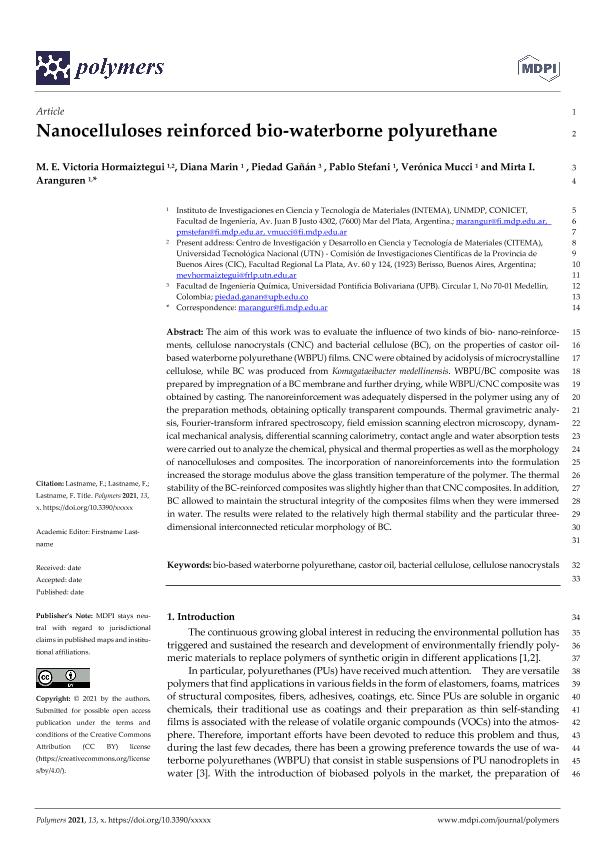Artículo
Nanocelluloses Reinforced Bio-Waterborne Polyurethane
Hormaiztegui, Maria Eugenia Victoria ; Marin, Diana; Gañán, Piedad; Stefani, Pablo Marcelo
; Marin, Diana; Gañán, Piedad; Stefani, Pablo Marcelo ; Mucci, Veronica Lujan
; Mucci, Veronica Lujan ; Aranguren, Mirta Ines
; Aranguren, Mirta Ines
 ; Marin, Diana; Gañán, Piedad; Stefani, Pablo Marcelo
; Marin, Diana; Gañán, Piedad; Stefani, Pablo Marcelo ; Mucci, Veronica Lujan
; Mucci, Veronica Lujan ; Aranguren, Mirta Ines
; Aranguren, Mirta Ines
Fecha de publicación:
08/2021
Editorial:
Multidisciplinary Digital Publishing Institute
Revista:
Polymers
e-ISSN:
2073-4360
Idioma:
Inglés
Tipo de recurso:
Artículo publicado
Clasificación temática:
Resumen
The aim of this work was to evaluate the influence of two kinds of bio-nano-reinforcements, cellulose nanocrystals (CNCs) and bacterial cellulose (BC), on the properties of castor oil-based waterborne polyurethane (WBPU) films. CNCs were obtained by the acidolysis of microcrystalline cellulose, while BC was produced from Komagataeibacter medellinensis. A WBPU/BC composite was prepared by the impregnation of a wet BC membrane and further drying, while the WBPU/CNC composite was obtained by casting. The nanoreinforcement was adequately dispersed in the polymer using any of the preparation methods, obtaining optically transparent compounds. Thermal gravimetric analysis, Fourier-transform infrared spectroscopy, field emission scanning electron microscopy, dynamical mechanical analysis, differential scanning calorimetry, contact angle, and water absorption tests were carried out to analyze the chemical, physical, and thermal properties, as well as the morphology of nanocelluloses and composites. The incorporation of nanoreinforcements into the formulation increased the storage modulus above the glass transition temperature of the polymer. The thermal stability of the BC-reinforced composites was slightly higher than that of the CNC composites. In addition, BC allowed maintaining the structural integrity of the composites films, when they were immersed in water. The results were related to the relatively high thermal stability and the particular three-dimensional interconnected reticular morphology of BC.
Archivos asociados
Licencia
Identificadores
Colecciones
Articulos(INTEMA)
Articulos de INST.DE INV.EN CIENCIA Y TECNOL.MATERIALES (I)
Articulos de INST.DE INV.EN CIENCIA Y TECNOL.MATERIALES (I)
Citación
Hormaiztegui, Maria Eugenia Victoria; Marin, Diana; Gañán, Piedad; Stefani, Pablo Marcelo; Mucci, Veronica Lujan; et al.; Nanocelluloses Reinforced Bio-Waterborne Polyurethane; Multidisciplinary Digital Publishing Institute; Polymers; 13; 17; 8-2021; 1-15
Compartir
Altmétricas



